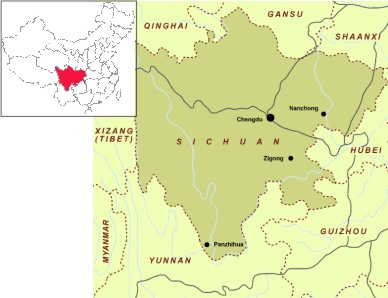MIAO, SICHUAN, CINA
Community Food System Datatables
Introduction

This field study was carried out in the town of Gongquan in Gong county within the Sichuan province of China. The Sichuan province is one of the seven provinces where 8 million Miao minority nationalists have now migrated to. Such wide-spread migrations have resulted in the many distinct yet similar languages, foods and clothes of the Miao today. The Miao are said to be one of the most ancient and largest nationalities of China.
Map is from: www.ibiblio.org/chinesehistory/ images/atlas/provincial/sichuan.html
The working team consisted of the following members including staff and experts from national, provincial and county levels:
National level
- Principle Investigator:
- Zhai Fengying, Professor
Deputy Director, Institute of Nutrition and Food Safety
Chinese Center for Disease Control and Prevention
- Zhai Fengying, Professor
- Co-Investigator:
- Li Dan, Associate Professor
Deputy Director, National Center for Chronic and Non-communicable Disease Control and Prevention
Chinese Center for Disease Control and Prevention
- Li Dan, Associate Professor
- Laboratory test researcher:
- Shi Lei, Research Assistant
Institute of Nutrition and Food Safety
Chinese Center for Disease Control and Prevention
- Shi Lei, Research Assistant
Provincial level
- Wu Xianping, Associate Professor
Center for Disease Control and Prevention of Sichuan Province - Jiang Shifen, Assistant Professor
Center for Disease Control and Prevention of Sichuan Province - Xian Shiju, Associate Professor
Center for Health Inspection of Sichuan Province - He Yonghong, Associate Professor
Center for Disease Control and Prevention of Sichuan Province
County level
- Xu Zhong, Vice Secretary
Gong County General Committee, Sichuan Province - Wang Guangzhu, Deputy Director
Gong County Government - Wang Shuhua, Deputy Director
Gong County Government - Liang Wei, Director
Health Bureau, Gong County - Zhang Shengrong, Director
Health and Anti-epidemic Station, Gong County - Zhang Juntang, Secretary
Health and Anti-epidemic Station, Gong County - He Lijuan, Chief
Health and Anti-epidemic Station, Gong Country - Li Yong, Deputy Director>br /> General Office, Gong County Government
- Zhang Bihua, Deputy Director Health Bureau, Gong County Government
- Sun Xiyou, Deputy Director Health and Anti-epidemic Station, Gong Country
The Center for Indigenous Peoples’ Nutrition and Environment (CINE), McGill University
- Professor Dr Harriet Kuhnlein
Photographs were taken by Peter Kuhnlein and Lisa Lynne Macdonald.
Notes on food groups
The information on various foods consumed by Miao was gathered in the Sichuan province. Due to financial constraints, sampling and nutrient analysis of only 4 foods were possible (refer to pages 45 – 48 in ‘Vegetable Category’. These foods are not currently found in the national Chinese food composition database. Nutrient analysis was carried out by the Department of Food Chemistry at the National Institute of Nutrition and Food Hygiene (INFH) in Beijing. All other information was gathered by focus group discussion and individual interviews carried out within the community.
Users should be aware that the data presented here do not represent absolute values. The purpose of this publication is to present a true reflection of the usual composition of foods as available and/or consumed among Miao community members. This is a living document and nutrient information will be added and/or updated when available.
Data were collected for a total of 80 food items which were then divided into seven food groups:
- Maio Datatables: Cereals and Millet
- Miao Datatables: Vegetables
- Miao Datatables: Fruit
- Miao Datatables: Nuts
- Miao Datatables: Meat
- Miao Datatables: Fish
- Miao Datatables: Miscellaneous Foods
Apart from the four local foods, nutrient information for the remaining foods is mainly sourced from the China Food Composition Database, 2002 (electronic version) which is referenced in the tables.
Local food names are recorded by either their local names or by mandarin names along with Chinese descriptor. The Scientific identification and English names were also determined when possible.
Notes on food components
There are approximately 16 to 18 components in the main body of the tables, which are presented in a fixed format for each record. The order of presentation is based on major nutrients categories.
The information on the analytical details for majority of the components can be obtained from the referenced literature.
Energy
Energy is expressed in unit of kilocalories (kcal). All energy values are calculated from the energy producing food components using the following conversion factors:
- Protein: 4 kcal/g
- Carbohydrate: 4 kcal/g
- Fat: 9 kcal/g
- Alcohol: 7 kcal/g
The calculated energy value of some foods in the tables varies from the energy value reported in the China Food Composition Database, 2002.
Carbohydrate
The carbohydrate content of food in the tables is reported in g/100g of edible portion (EP) was estimated as:
Carbohydrate=100 – (Water + Protein + Fat + Ash)
Dietary fibre
The dietary fibre content shown in the tables refers to insoluble fibre, determined using the neutral detergent method. Insoluble fibre includes cellulose, insoluble hemicellulose, and lignin etc. The fibre content is shown as g/100g of EP for each food.
Vitamin A
Vitamin A values are reported in only Vitamin A retinol equivalents (RE-μg) and are sourced from China Food Composition Database 2002. Vitamin A RAE values are calculated and reported for compatibility with the DRI (Dietary Reference Intake) recommendations.
References
China Food Composition Database 2002. Institute for Nutrition and Food Safety, China CDC (electronic version)
www.plants.USDA.gov/
http://edis.ifas.ufl.edu/mv036
http://www.anapsid.org/resources/vegetablenames.html
http://www.plantnames.unimelb.edu.au/
http://www.pfaf.org/database/plants.php
Department of Food Chemistry, National Institute of Nutrition and Food Hygiene (INFH) in Beijing.
http://www.dnr.state.oh.us/wildlife/fishing